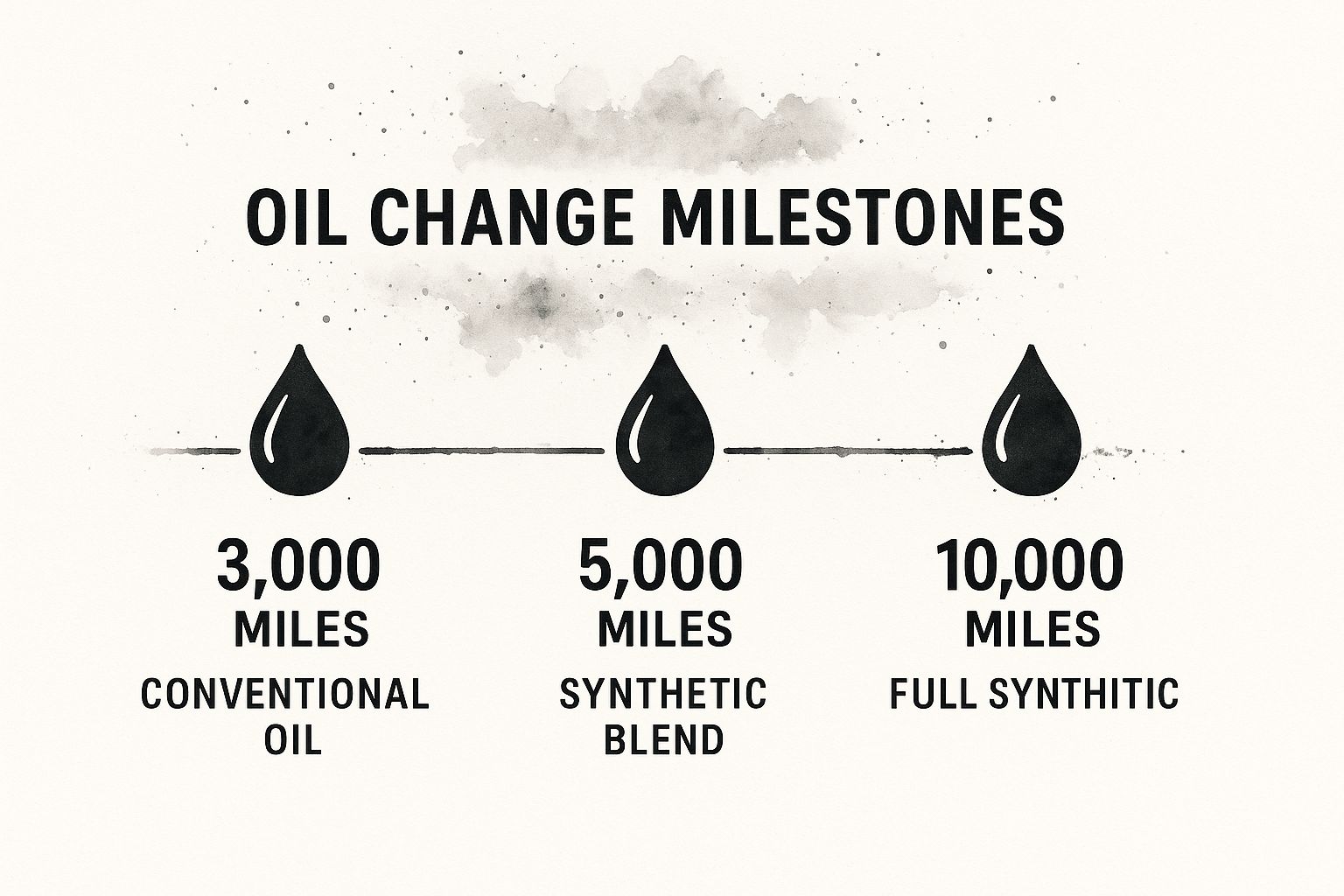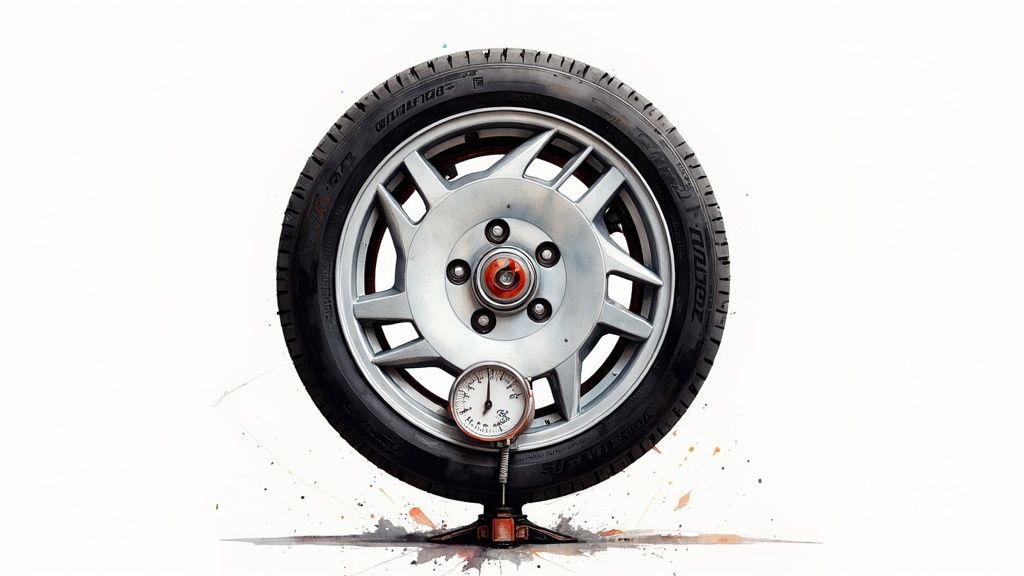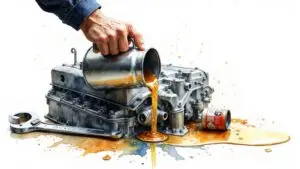Keep Your Ride in Top Shape: A Mileage-Based Car Care Guide
This car maintenance schedule by mileage covers seven essential services to keep your vehicle running smoothly and prevent costly repairs. From oil changes to transmission service, learn when to schedule key maintenance based on your car’s mileage. This guide helps Haltom City, Keller, Watauga, and North Richland Hills, TX drivers, fleet managers, and busy professionals maintain their vehicles effectively. Following a car maintenance schedule by mileage ensures safety, maximizes performance, and extends the life of your car. Stay informed and take proactive steps to protect your investment.
1. Oil and Filter Change
Regular oil and filter changes are the cornerstone of any effective car maintenance schedule by mileage. Engine oil is the lifeblood of your vehicle, lubricating moving parts, minimizing friction, regulating temperature, and removing harmful contaminants. Without fresh oil, your engine’s performance and lifespan are severely compromised. As you accumulate mileage, the oil breaks down and becomes less effective, making regular changes crucial.

This process typically involves draining the old, contaminated oil, replacing the oil filter (which traps debris), and refilling the engine with fresh oil. Different types of oil are available, including conventional, synthetic blend, full synthetic, and high-mileage oils, each offering varying levels of protection and longevity. Choosing the right oil depends on your vehicle’s make, model, age, and driving conditions. For residents of Haltom City, Keller, TX, Watauga, TX, and North Richland Hills, TX, finding a reputable service center that understands your specific car’s needs is essential.
The infographic below visualizes the typical timeline of oil degradation and the importance of adhering to a regular oil change schedule based on mileage.

As you can see, regular oil changes are essential to maintain the effectiveness of your car’s engine. Failing to change your oil can lead to sludge build-up and premature engine wear.
Benefits of regular oil and filter changes:
- Extended engine life: This is perhaps the most significant benefit. Clean oil significantly reduces friction and wear on engine components, leading to a longer-lasting engine.
- Improved fuel efficiency: Clean oil allows the engine to run more smoothly and efficiently, potentially improving your gas mileage.
- Prevents overheating: Oil helps regulate engine temperature, preventing overheating and potential damage.
- Relatively inexpensive: Compared to the cost of major engine repairs resulting from neglect, oil changes are a very affordable preventative measure.
Potential drawbacks:
- Ongoing expense: Oil changes are a recurring cost of car ownership.
- Environmental impact: Proper disposal of used oil is essential to minimize environmental harm.
- Varying service intervals: Manufacturer recommendations for oil change frequency can vary widely, sometimes leading to confusion.
Examples of manufacturer recommendations and best practices:
- Toyota typically recommends 5,000-10,000 mile intervals with synthetic oil.
- High-performance vehicles like BMW or Mercedes often require specific synthetic oils and more frequent changes.
Tips for incorporating oil changes into your car maintenance schedule by mileage:
- Consult your owner’s manual: Your owner’s manual provides the manufacturer’s recommended oil change intervals specific to your vehicle. This is the best resource for creating a personalized car maintenance schedule by mileage.
- Consider synthetic oil: Synthetic oil often allows for extended change intervals, potentially saving you money and time in the long run.
- Use the correct oil viscosity: Always use the oil viscosity grade specified by your vehicle manufacturer for optimal performance and protection.
- Maintain records: Keep detailed records of your oil changes to maintain warranty coverage and track your vehicle’s maintenance history.
Learn more about Oil and Filter Change
This crucial maintenance task deserves the top spot on any car maintenance schedule by mileage because it directly impacts the longevity, performance, and reliability of your vehicle’s engine. Popularized by companies like Jiffy Lube, Valvoline, Mobil 1, and Pennzoil, the importance of regular oil and filter changes is universally recognized in the automotive industry.
2. Tire Rotation and Pressure Check
As part of any comprehensive car maintenance schedule by mileage, tire rotation and pressure checks play a crucial role in vehicle safety, performance, and longevity. Tire rotation involves moving tires from one position to another on the vehicle to promote even wear. This, combined with keeping tires properly inflated, maximizes tire lifespan and ensures optimal handling and fuel efficiency. Neglecting this essential maintenance can lead to premature tire wear, compromised safety, and decreased fuel economy.

Tire rotations are typically recommended every 5,000-8,000 miles, although this can vary depending on the vehicle manufacturer and driving conditions. Different rotation patterns exist depending on whether your vehicle is front-wheel drive (FWD), rear-wheel drive (RWD), or all-wheel drive (AWD). For example, Honda recommends tire rotation every 7,500 miles. Tire manufacturers like Michelin and Goodyear also emphasize regular rotation as part of maintaining warranty coverage. Pressure checks should be performed at least monthly and always before embarking on long trips. This helps ensure optimal tire performance and fuel economy.
This maintenance item deserves a prominent place on the car maintenance schedule by mileage because of its significant impact on several key areas. Properly inflated and rotated tires contribute to improved fuel economy, extending the life of your tires by up to 20%. Furthermore, they enhance vehicle handling and safety by providing better traction and responsiveness. Maintaining correct tire pressure also helps maintain proper wheel alignment, further contributing to even tire wear. Learn more about Tire Rotation and Pressure Check. This is especially important for residents of Haltom City, Keller, Watauga, and North Richland Hills, TX, who rely on their vehicles for daily commutes and other travel.
Pros:
- Extends tire life by up to 20%
- Improves fuel economy
- Enhances vehicle handling and safety
- Helps maintain proper alignment
Cons:
- Requires special equipment for proper lifting and torquing
- Directional tires have limitations on rotation patterns
- Cannot compensate for severe alignment issues
Tips for Optimal Tire Rotation and Pressure Checks:
- Check pressure when cold: Tire pressure should be checked when the tires are cold for the most accurate reading.
- Consult your owner’s manual: Adhere to the specific rotation pattern recommended in your vehicle’s owner’s manual.
- Proper torquing: Ensure wheels are properly torqued to manufacturer specifications after rotation.
- Combine with oil changes: Schedule tire rotations to coincide with oil changes for added convenience.
- Inspect for damage: During rotation, inspect tires for any signs of damage, abnormal wear, or embedded objects.
By following these guidelines and including tire rotation and pressure checks in your car maintenance schedule by mileage, you can significantly extend the lifespan of your tires, improve your vehicle’s performance, and enhance overall safety on the road, which is vital for all drivers, including busy professionals, fleet managers, and safety-conscious individuals in our service area.
3. Brake System Inspection and Service
Maintaining your vehicle’s brake system is paramount for safety and optimal performance, making it a crucial part of any car maintenance schedule by mileage. This system, responsible for slowing and stopping your vehicle, relies on several interconnected components including brake pads, rotors, calipers, fluid, and lines. As these components wear down through normal use – and especially with frequent heavy braking – regular inspection and timely replacement are essential to prevent brake failure and ensure you can stop safely and effectively. A well-maintained brake system not only protects you and your passengers but also helps prevent more costly repairs down the line by catching potential issues early.

A typical brake system inspection, recommended every 10,000-15,000 miles as part of your car maintenance schedule by mileage, involves a thorough check of the entire system. Technicians will examine the brake pads for wear and tear, measure rotor thickness, and inspect calipers for proper function. They’ll also check the brake lines for leaks and assess the condition of the brake fluid. Learn more about Brake System Inspection and Service. Depending on the inspection findings and your vehicle’s mileage, further service may be recommended. Brake pad replacement is usually needed every 30,000-70,000 miles, while rotors might require resurfacing or replacement within the same mileage range. Brake fluid, which is crucial for maintaining hydraulic pressure, should be flushed every 2-3 years or 24,000-36,000 miles.
For instance, a Toyota Camry typically requires brake pad replacement around the 50,000-mile mark, while high-performance vehicles like Porsche, with their more robust braking systems, often require more frequent service. Residents of Haltom City, Keller, Watauga, and North Richland Hills, TX, understand the importance of regular car maintenance, especially with the varied driving conditions in the area. Whether you’re a busy professional seeking fast and reliable service, a fleet manager overseeing company vehicles, or a safety-conscious driver valuing certified technicians, understanding your brake system’s maintenance needs is vital.
Pros of Regular Brake System Maintenance:
- Critical for vehicle and passenger safety: Ensures optimal stopping power and prevents accidents.
- Prevents expensive repairs: Early detection of issues avoids costly component damage down the line.
- Maintains optimal stopping distance: Provides peace of mind knowing your brakes will perform as expected.
- Early detection of hydraulic system issues: Prevents potentially dangerous leaks and failures.
Cons of Regular Brake System Maintenance:
- Replacement parts can be expensive: Premium vehicles and high-performance parts can increase costs.
- Frequent heavy braking reduces component lifespan: Driving style can impact service intervals.
- Quality varies among aftermarket parts: Choosing reputable brands like Brembo, Akebono, or Wagner is essential.
Tips for Maintaining Your Brake System:
- Listen for squealing or grinding noises, which often indicate worn brake pads.
- Check for brake fluid that appears dark or contaminated – it should be a clear amber color. If it’s dark brown, it’s time for a change.
- Consider upgrading to ceramic brake pads for reduced dust and noise.
- Have both axles serviced simultaneously for balanced braking performance.
This item deserves a prominent place in any car maintenance schedule by mileage due to its direct impact on safety. By adhering to recommended service intervals and being proactive with inspections, you can ensure optimal braking performance, prevent costly repairs, and most importantly, keep yourself and others safe on the road.
4. Air Filter Replacement
Air filter replacement is a crucial part of any car maintenance schedule by mileage. This simple yet effective maintenance task contributes significantly to engine health, performance, and longevity. It deserves its place on this list due to its impact on fuel efficiency, engine protection, and overall cost-effectiveness.
The engine air filter acts as your engine’s first line of defense, preventing dust, debris, pollen, and other contaminants from entering the combustion chamber. It works by forcing the incoming air through a filtering medium, trapping the unwanted particles while allowing clean air to pass through for proper combustion. A clean air filter ensures the correct air-to-fuel ratio, which is vital for optimal engine performance and fuel efficiency.
As the air filter performs its duty, it gradually accumulates contaminants, becoming clogged and restricting airflow. This reduced airflow “suffocates” the engine, leading to decreased performance, reduced fuel economy, and potentially increased emissions.
Features and Benefits:
- Replacement Interval: Typically every 15,000-30,000 miles as part of your car maintenance schedule by mileage, although this varies significantly based on driving conditions. For example, a Ford F-150 generally recommends replacement every 30,000 miles under normal driving conditions.
- Filter Types: Various types of air filters are available, including paper, gauze, foam, and cotton. Each type offers different levels of filtration and airflow.
- Engine vs. Cabin Air Filters: Modern vehicles often have separate filters for the engine and the cabin. While this section focuses on the engine air filter, remember that the cabin air filter also needs periodic replacement for clean interior air.
Pros:
- Improved Fuel Efficiency: A clean air filter can improve fuel efficiency by up to 10%, directly impacting your wallet and the environment.
- Engine Protection: By preventing abrasive particles from entering the engine, the air filter protects internal components from premature wear and tear, reducing the risk of costly repairs.
- Cost-Effective: Air filters are relatively inexpensive and often easy to replace yourself (DIY-friendly), making this a budget-friendly maintenance item.
- Maintains Air-to-Fuel Ratio: Ensures the proper mixture of air and fuel for optimal combustion, impacting performance and emissions.
Cons:
- Variable Replacement Intervals: Driving conditions significantly affect how often the air filter needs replacing. Vehicles driven in dusty environments like construction sites or desert regions, such as around Keller, TX, Watauga, TX, North Richland Hills, TX, and Haltom City, may require changes as frequently as every 15,000 miles.
- Premium Filter Cost: While some premium filters (like those from K&N Filters, FRAM, Wix, or Bosch) promise enhanced performance, they often come at a higher cost and may not always deliver proportional benefits.
Actionable Tips:
- Visual Inspection: Hold the air filter up to a light source. If light doesn’t pass through easily, it’s time for a replacement. This simple check can be integrated into your car maintenance schedule by mileage.
- Reusable Filters: Consider using a reusable air filter for potential long-term cost savings, although these require regular cleaning and maintenance.
- Clean the Housing: When replacing the filter, take a moment to clean the air filter housing to remove any accumulated debris.
- Record Keeping: Keep records of your air filter replacements to establish optimal replacement intervals based on your specific driving conditions and location in areas like Haltom City.
- Cabin Air Filter: Replace the cabin air filter simultaneously with the engine air filter for comprehensive air system maintenance and improved interior air quality.
By incorporating regular air filter replacements into your car maintenance schedule by mileage, you can ensure optimal engine performance, improve fuel economy, and protect your engine from unnecessary wear. This simple maintenance task offers significant benefits for vehicle owners of all types, from busy professionals to fleet managers in the DFW area and beyond.
5. Coolant System Flush and Inspection
As part of your car maintenance schedule by mileage, a coolant system flush and inspection is crucial for preventing costly engine damage. This service plays a vital role in maintaining your vehicle’s health, contributing significantly to its longevity and performance. It’s a preventative measure that addresses the wear and tear on the cooling system that occurs over time, ensuring efficient operation and avoiding potential breakdowns.
The engine cooling system prevents overheating by circulating coolant (also known as antifreeze) through the engine block and radiator. This coolant absorbs heat from the engine and dissipates it through the radiator. Over time, coolant degrades, losing its protective properties and becoming acidic. This can lead to corrosion within the system, deposit buildup that restricts flow, and reduced cooling efficiency.
A cooling system flush involves removing the old, contaminated coolant and replacing it with fresh fluid. The inspection component of this service involves checking all the critical parts of the cooling system including hoses, the radiator, water pump, and thermostat for leaks, cracks, or other signs of wear and tear. This preventative maintenance is generally recommended every 30,000-60,000 miles or 2-5 years, depending on the vehicle manufacturer’s recommendations and the type of coolant used. Modern vehicles often use long-life coolants that can extend the service interval.
Features of a Coolant System Flush and Inspection:
- Complete system flush to remove all old coolant and contaminants.
- Replacement with fresh coolant formulated for your vehicle.
- Thorough inspection of hoses, radiator, water pump, and thermostat.
- Identification of potential leaks or weaknesses in the system.
Pros:
- Prevents engine overheating and catastrophic failures: A well-maintained cooling system is paramount to preventing overheating, which can lead to warped cylinder heads, cracked engine blocks, and other expensive repairs.
- Removes corrosive contaminants: Flushing eliminates the acidic buildup that can damage cooling system components.
- Identifies leaks and weak points: The inspection identifies potential problems before they cause a breakdown on the road.
- Extends water pump and heater core life: Fresh coolant helps lubricate the water pump and prevents corrosion in the heater core.
Cons:
- Proper disposal of used coolant required: Used coolant is an environmental hazard and must be disposed of properly.
- Modern cooling systems can be complex: Some vehicles have multiple drain points and specific procedures that must be followed for a complete flush.
- Different vehicles require specific coolant types: Using the incorrect type of coolant can lead to reduced cooling system efficiency and potential damage. Never mix coolant types.
Examples of Successful Implementation:
- BMW recommends cooling system service every 60,000 miles using their specific BMW coolant. This ensures optimal performance and longevity of the cooling system in their vehicles.
- Subaru engines, with their unique boxer design, have specific cooling system requirements and are known to be particularly sensitive to overheating. Adhering to their recommended maintenance schedule is crucial.
Actionable Tips:
- Never open a hot radiator cap: The system is pressurized, and hot coolant can cause severe burns. Allow the engine to cool completely before opening the cap.
- Use only the coolant type specified by your vehicle manufacturer: Using the wrong coolant can damage your cooling system. Check your owner’s manual for the correct type.
- Properly bleed air from the system after refilling: Air pockets can reduce cooling efficiency and lead to overheating. Consult your owner’s manual for the correct bleeding procedure.
- Inspect for calcium deposits or oil contamination: These can indicate other underlying issues with the engine or cooling system.
- Consider pressure testing the cooling system: This can help identify small leaks that might not be readily visible.
This service is essential for all vehicle owners in areas like Haltom City, Keller, Watauga, and North Richland Hills, TX, especially given the fluctuating temperatures. Sticking to a regular car maintenance schedule by mileage, including coolant system flushes and inspections, will help keep your vehicle running smoothly and prevent costly repairs down the road. It’s a worthwhile investment in your car’s longevity and your peace of mind.
6. Transmission Fluid Service
Maintaining your vehicle according to a car maintenance schedule by mileage is crucial for its longevity and performance. A vital part of this schedule is transmission fluid service. This service ensures your transmission continues to operate smoothly and efficiently, preventing costly repairs down the road.
Transmission fluid is the lifeblood of your automatic transmission. It lubricates the intricate moving parts, cools the system, and transmits power from the engine to the wheels. Over time, however, heat and friction break down the fluid, causing it to lose its protective properties. This degradation can lead to rough shifting, overheating, and ultimately, transmission failure. A transmission service addresses this by replacing the old, degraded fluid and, in many cases, replacing the filter and cleaning internal components.
Why this deserves a place in your car maintenance schedule by mileage:
A healthy transmission is essential for a properly functioning vehicle. Ignoring transmission service can lead to premature failure, which is a significantly more expensive repair than routine fluid changes. Including this service in your car maintenance schedule by mileage helps prevent major issues and keeps your vehicle running smoothly.
Features and Benefits:
- Extended Transmission Life: Regular fluid changes are the best way to extend the life of your transmission, protecting your investment.
- Smooth Shifting: Fresh fluid ensures proper lubrication and hydraulic pressure, resulting in smooth and responsive gear changes.
- Prevents Overheating: Clean fluid effectively dissipates heat, preventing overheating and damage to internal components.
- Cost Savings: Regular service is much less expensive than a transmission rebuild or replacement.
Pros:
- Significantly extends transmission life
- Maintains shift quality and responsiveness
- Prevents overheating and premature failure
- Much less expensive than transmission replacement
Cons:
- Some manufacturers claim “lifetime” fluid, leading to confusion about service intervals. However, even these fluids benefit from eventual replacement.
- A complete flush on a high-mileage transmission with pre-existing issues can sometimes exacerbate those problems. However, regular maintenance mitigates this risk.
- Service costs are slightly higher than other fluid changes.
- Some specialty fluids, especially for CVT or dual-clutch transmissions, can be more expensive.
Examples of Successful Implementation:
- Honda CVT transmissions: These often require specific Honda HCF-2 fluid changed every 60,000 miles as part of a responsible car maintenance schedule by mileage.
- Toyota Automatic Transmissions: Toyota generally recommends fluid service every 60,000-100,000 miles, contributing to their vehicles’ known reliability.
Actionable Tips for Haltom City, Keller, Watauga, and North Richland Hills Drivers:
- Check Your Fluid: Regularly check your transmission fluid’s color and smell. It should be red or pink, not brown or burnt smelling.
- Adjust for Severe Conditions: If you frequently tow or drive in extreme temperatures, consider shorter service intervals in your car maintenance schedule by mileage.
- Flush with Caution: Be cautious with flush machines, especially on high-mileage transmissions, and consult with a trusted mechanic.
- Use the Correct Fluid: Always use the exact fluid type specified by your vehicle’s manufacturer – this is crucial.
- Consider a Cooler: If you use your vehicle in demanding conditions, adding a transmission cooler can further protect your transmission.
When and Why to Use This Approach:
Transmission fluid service should be a regular part of your car maintenance schedule by mileage. Consult your owner’s manual for the recommended interval. Sticking to this schedule, especially if you live in the demanding climates of Haltom City, Keller, Watauga, or North Richland Hills, TX, will help prevent expensive repairs and keep your car running smoothly for years to come. Even if your manufacturer claims “lifetime” fluid, consider changing it at least every 100,000 miles.
By following these guidelines and incorporating transmission fluid service into your car maintenance schedule by mileage, you’ll ensure your vehicle’s transmission stays healthy and performs at its best.
7. Spark Plug Replacement
Spark plug replacement is a crucial part of any car maintenance schedule by mileage. These small but mighty components are responsible for igniting the air-fuel mixture in your gasoline engine, initiating the combustion process that powers your vehicle. Over time, the electrode gap on spark plugs widens due to wear, and deposits can accumulate, requiring more voltage for a spark. This can lead to misfires, reduced engine power, rough idling, and decreased fuel economy. Adhering to a proper replacement schedule based on your vehicle and spark plug type ensures optimal ignition, contributing to better performance, lower emissions, and improved fuel efficiency. This is especially important for residents of Haltom City, Keller, Watauga, and North Richland Hills, TX, where consistent vehicle performance is essential for navigating the varied driving conditions.
How Spark Plugs Work:
Spark plugs work by using high voltage electricity to create a spark across a small gap between two electrodes. This spark ignites the compressed air-fuel mixture within the cylinder, initiating the combustion process. The heat and pressure generated from this controlled explosion push the piston down, ultimately turning the crankshaft and powering the vehicle.
Spark Plug Types and Replacement Intervals (Car Maintenance Schedule by Mileage):
The lifespan of a spark plug depends on its material composition:
- Copper: These traditional plugs typically require replacement every 30,000-40,000 miles as part of your car maintenance schedule by mileage.
- Platinum: Offering a longer lifespan, platinum plugs are often replaced every 60,000-100,000 miles.
- Iridium: These provide the longest service life, generally requiring replacement every 80,000-120,000 miles.
Modern engines may have one or multiple spark plugs per cylinder, impacting the overall replacement job. Consult your owner’s manual for specific recommendations for your vehicle.
Pros of Timely Spark Plug Replacement:
- Improved Fuel Economy: Worn spark plugs can decrease fuel economy. Replacing them can improve fuel efficiency by up to 30% in some cases, saving you money at the pump.
- Restored Performance: New spark plugs can restore lost engine power and smooth out a rough idle, providing a more responsive and enjoyable driving experience.
- Reduced Emissions: Efficient combustion contributes to cleaner exhaust, reducing harmful emissions and minimizing your environmental impact.
- Reliable Cold-Weather Starting: Fresh spark plugs ensure reliable ignition, especially in cold weather, when starting can be more challenging.
Cons of Spark Plug Replacement:
- Accessibility: Depending on the engine design, accessing spark plugs can sometimes be difficult, potentially adding to labor costs.
- Cost: Premium platinum or iridium plugs are more expensive than standard copper plugs. However, their extended lifespan often offsets the higher initial cost.
- Improper Installation: Incorrect installation can damage cylinder heads or plug threads. It’s crucial to use the correct tools and techniques.
- Torque: Applying the correct torque during installation is essential to prevent damage to the spark plugs and cylinder head.
Examples of Specific Applications:
- Ford EcoBoost engines utilize specific platinum-tipped plugs that require precise gapping for optimal performance.
- Subaru boxer engines often necessitate special tools for accessing and replacing spark plugs due to their unique configuration.
Tips for Spark Plug Replacement:
- Gapping: Always gap new spark plugs to the manufacturer’s specifications before installation.
- Anti-Seize Compound: Use anti-seize compound sparingly on the plug threads, following manufacturer recommendations. Too much can negatively impact performance.
- Inspection: Examine old spark plugs for unusual deposits or wear patterns. This can provide insights into other potential engine issues.
- Simultaneous Replacement: Replace all spark plugs at the same time to ensure balanced engine performance.
- Upgrade: Consider upgrading to iridium plugs for their extended service life and potential performance benefits.
Popular Spark Plug Brands: NGK, Denso, Bosch, and Champion are reputable brands known for producing high-quality spark plugs.
Spark plug replacement is a fundamental element of a proactive car maintenance schedule by mileage. By adhering to the recommended replacement intervals and following best practices, you can maintain optimal engine performance, improve fuel efficiency, and reduce harmful emissions, contributing to a more reliable and enjoyable driving experience for drivers in Haltom City, Keller, Watauga, and North Richland Hills, TX.
7-Point Car Maintenance Comparison by Mileage
| Maintenance Task | Implementation Complexity 🔄 | Resource Requirements ⚡ | Expected Outcomes 📊 | Ideal Use Cases 💡 | Key Advantages ⭐ |
|---|---|---|---|---|---|
| Oil and Filter Change | Moderate – requires draining and refilling oil, filter replacement | Moderate – oil, filter, proper disposal needed | Prolonged engine life, better fuel efficiency, prevents overheating | Regular engine upkeep, every 3,000-10,000 miles | Extends engine life, cost-effective, improves efficiency |
| Tire Rotation and Pressure Check | Low to Moderate – rotation patterns vary by drive type | Low – lifting equipment, pressure gauge | Even tire wear, improved handling, enhanced safety | Routine tire maintenance, every 5,000-8,000 miles | Extends tire life, improves fuel economy, enhances safety |
| Brake System Inspection and Service | Moderate to High – inspection plus parts replacement | Moderate to High – pads, rotors, fluid, tools | Safe braking, prevents costly repairs, early issue detection | Safety-critical maintenance, 10,000-15,000 mile inspection | Critical safety task, maintains stopping power, prevents failures |
| Air Filter Replacement | Low – usually easy to access and replace | Low – replacement filter | Improved fuel efficiency, engine protection | Engines in dusty environments, every 15,000-30,000 miles | Improves fuel economy, protects engine, inexpensive and DIY-friendly |
| Coolant System Flush and Inspection | Moderate – involves flushing, refill, and inspection | Moderate – coolant, disposal and inspection tools | Prevents overheating, system longevity | Cooling system care, every 30,000-60,000 miles | Prevents overheating, corrosion control, leak detection |
| Transmission Fluid Service | Moderate to High – may involve flush, filter change | Moderate to High – specific fluids, filters, sometimes flush machine | Maintains smooth shifting, extends transmission life | Transmission maintenance, varies 30,000-100,000 miles | Extends transmission life, prevents failure, maintains shift quality |
| Spark Plug Replacement | Moderate – can be difficult access on some engines | Low to Moderate – spark plugs, possible special tools | Restored engine power, better fuel efficiency, smoother idle | Combustion performance, 30,000-120,000 mile intervals | Improves fuel economy, restores performance, reduces emissions |
Stay Ahead of the Curve: Proactive Car Care with Express Lube
Sticking to a regular car maintenance schedule by mileage is crucial for the health and longevity of your vehicle. From oil changes and tire rotations to brake inspections and coolant system flushes, addressing these key maintenance points, as outlined above, can prevent costly repairs down the road and ensure your car runs smoothly for years to come. Remember, proactive maintenance is always better—and often less expensive—than reactive repairs. Mastering a preventative approach to car care empowers you to avoid breakdowns, enhance fuel efficiency, and maintain your vehicle’s value. For a more detailed guide on car maintenance schedules based on mileage, check out this helpful resource: car maintenance schedule by mileage from Kwik Kar of Mesquite.
Keeping your vehicle in top shape offers peace of mind knowing you’re prepared for the road ahead, whether it’s a daily commute or a long road trip. By following a car maintenance schedule by mileage, you’re not just maintaining your car – you’re investing in its future and yours. Simplify your car care routine and ensure your vehicle receives expert attention by visiting Express Lube and Car Care. We offer comprehensive maintenance services tailored to your car’s mileage, helping you stay on track with your car maintenance schedule by mileage. Schedule your next service appointment with Express Lube and Car Care today and experience the difference proactive maintenance can make.






